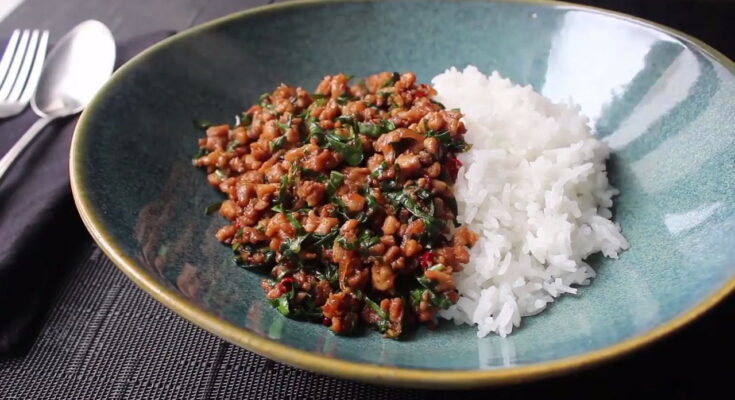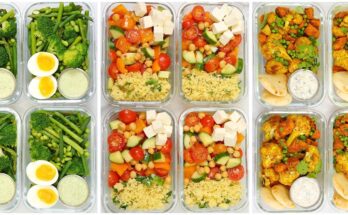Basil Chicken Recipe: Basil Chicken, often known as Thai Basil Chicken or “Pad Krapow Gai,” is one of those dishes that instantly elevates your taste buds to a whole new level. It’s fragrant, spicy, and loaded with savory-sweet flavors that hit all the right notes. Imagine tender chicken infused with garlic, chili, and the unique aroma of Thai basil—each bite is a rollercoaster of taste.
So, why should Basil Chicken be on your dinner rotation? Because it’s ridiculously easy to make, requires minimal ingredients, and packs in gourmet-level flavor without hours of cooking. This dish is a favorite for weeknight dinners, quick lunches, and even special occasions where you want to impress without stress.
It’s one of those meals that turns humble chicken into a showstopper. Plus, the adaptability is amazing—you can go as spicy or mild as you want, serve it with rice, noodles, or even lettuce wraps. The best part? It’s healthy, protein-rich, and naturally gluten-free (just watch your soy sauce selection!).
Ingredients You’ll Need
Main Ingredients
To make an authentic and flavorful Basil Chicken, you’ll need a handful of basic ingredients. Here’s what should be on your shopping list:
- Chicken (500g or 1 lb) – Boneless, skinless chicken thighs or breasts work fine. Thighs are juicier.
- Fresh Thai Basil (1 cup) – The star of the show! Its peppery flavor brings life to the dish.
- Garlic (5-6 cloves) – Crushed or minced. Essential for that deep, savory aroma.
- Bird’s Eye Chilies (2-4) – Adjust based on heat preference.
- Soy Sauce (2 tbsp) – For umami depth.
- Oyster Sauce (1 tbsp) – Adds a glossy finish and sweet-savory flavor.
- Fish Sauce (1 tsp) – Optional but highly recommended for that authentic Southeast Asian taste.
- Sugar (1 tsp) – Helps balance the salt and spice.
- Vegetable Oil (2 tbsp) – For cooking.
Optional Add-ons for Extra Flavor
- Onions or shallots – For a slight sweetness.
- Bell peppers – Add color and crunch.
- Mushrooms – Earthy tones to complement the basil.
- Lime juice – A fresh zing at the end.
Having fresh and high-quality ingredients makes all the difference, especially the basil. Thai basil is preferable for its unique anise-like flavor, but sweet basil can be a substitute if you’re in a pinch.
Preparation Before Cooking
Prepping the Chicken
Start by cleaning and slicing your chicken into bite-sized pieces. You want uniform cuts so they cook evenly. Pat them dry to avoid steaming in the pan; a good sear makes a better texture. If you’re aiming for a leaner meal, use chicken breast. For more flavor and moisture, chicken thighs are the better pick.
Getting the Basil Ready
Pick the basil leaves from the stem and gently rinse them. Pat them dry with a paper towel. Thai basil wilts quickly, so only prep this step when you’re about to cook. The aroma from just the leaves will be strong—don’t chop them! You want them whole for the best texture and flavor release.
Chopping Vegetables and Aromatics
Mince your garlic and chilies. If you’re using optional ingredients like bell peppers or mushrooms, slice them thinly. This is also a good time to prepare your sauces—mix soy sauce, oyster sauce, fish sauce, and sugar in a small bowl for convenience.
Step-by-Step Cooking Instructions
Step 1 – Marinating the Chicken
While not absolutely necessary, marinating your chicken can enhance the flavor. Just mix a tablespoon of soy sauce and a teaspoon of fish sauce with your chicken and let it sit for 15–20 minutes. It’s enough time to infuse it with a savory base and tenderize the meat slightly.
Step 2 – Cooking the Aromatics
Heat your wok or skillet over medium-high heat and add the oil. Once hot, toss in the minced garlic and chilies. Stir quickly and let the aromatics infuse the oil—about 30 seconds to a minute. Be careful not to burn the garlic, as that will give a bitter taste. The smell at this stage is mouthwatering—smoky, spicy, and rich.
Step 3 – Sautéing the Chicken
Now add your marinated chicken to the hot pan. Spread it out so each piece gets contact with the heat. Let it sear undisturbed for a couple of minutes before stirring. Cook for about 6-8 minutes or until the chicken is golden and cooked through. Add in your pre-mixed sauces during this step. Let it coat every piece and start reducing slightly.
Step 4 – Adding the Basil and Final Touches
Once your chicken is cooked and the sauce is thickened slightly, toss in the basil leaves. Stir just until they wilt—no more than a minute. If using bell peppers or other veggies, add them now too, and cook for another 2-3 minutes. The goal is to keep some crunch and brightness.
Serve your Basil Chicken hot with a bowl of jasmine rice or noodles. You can also top it with a fried egg for that street-food-style Thai experience.
Tips for the Perfect Basil Chicken
Choosing the Right Basil
Not all basil is created equal. Thai basil has a slightly spicy, licorice-like flavor that makes this dish authentic. Sweet basil is more mellow and works if Thai basil isn’t available, but the punch of flavor won’t be quite the same.
Balancing the Flavors
The heart of any great stir-fry is balance. You want heat from the chilies, salt from the sauces, sweetness from sugar, and a fresh finish from the basil. Don’t overdo the fish sauce or it can overpower the dish. Always taste and adjust as you go. A splash of lime juice at the end can also lift the dish beautifully.
Variations of Basil Chicken
Spicy Basil Chicken
If you’re a fan of heat, turning this into a spicy Basil Chicken dish is incredibly simple. Add more bird’s eye chilies, or toss in a spoon of chili garlic paste or Sriracha while cooking. You can even finish it with a drizzle of chili oil for that extra fiery kick. The spicy version pairs especially well with a cooling cucumber salad or yogurt-based dip to balance things out.
Vegetarian Basil Chicken
Yes, you can totally enjoy this dish even if you’re plant-based! Swap the chicken with tofu or tempeh. Make sure to press and drain the tofu well so it crisps up nicely in the pan. Use vegetarian oyster sauce or hoisin sauce in place of the traditional one to keep it meat-free. The result? A hearty, spicy, basil-infused stir-fry that even meat-eaters will love.
Low-Carb/Keto-Friendly Basil Chicken
Watching your carbs? Skip the rice and serve Basil Chicken in lettuce wraps or over cauliflower rice. Since the dish is naturally low in sugar and high in protein, it’s an excellent choice for keto lovers. Just double-check your sauces for added sugars and use low-carb options where needed.
What to Serve with Basil Chicken
Classic White Rice
This is the most traditional pairing. The simplicity of white jasmine rice allows the bold flavors of the Basil Chicken to shine through. It also absorbs the sauce perfectly, giving you flavorful bites every time.
Sticky Rice
A bit more adventurous? Go for sticky rice. It’s chewy, a little sweet, and provides a delightful texture contrast. Perfect for soaking up every last drop of that basil-chili-garlic sauce.
Rice Noodles
Want something different? Basil Chicken tossed with flat rice noodles is a twist on Thai drunken noodles. It’s satisfying and still keeps all the flavor intact. Add some vegetables for extra crunch and nutrition.
Vegetable Stir-Fry
For a lighter, more balanced meal, serve your Basil Chicken with a side of quick veggie stir-fry. Broccoli, bell peppers, baby corn, and snap peas work wonderfully. Plus, the vibrant colors look amazing on the plate!
How to Store and Reheat Leftovers
Storing Leftovers
Have some Basil Chicken left? Lucky you! This dish stores really well.
- Refrigerator: Store in an airtight container for up to 3-4 days.
- Freezer: Basil doesn’t freeze very well, but if needed, freeze the chicken portion without basil. Add fresh basil when reheating.
Reheating Tips
To reheat, simply toss it in a skillet over medium heat with a splash of water or chicken broth. This keeps the chicken moist and brings the sauce back to life. Microwaving works too, but stir halfway to ensure even heating. Add fresh basil at the end for that fresh flavor boost.
Health Benefits of Basil Chicken
You may be surprised to know that this delicious dish is also quite nutritious:
- High in Protein: Great for muscle repair and staying full longer.
- Rich in Antioxidants: Thanks to garlic, basil, and chilies.
- Low in Sugar: Unlike many takeout dishes, you control the amount of sugar.
- Gluten-Free Option: Use gluten-free soy sauce or tamari to suit your dietary needs.
- Herbal Benefits: Thai basil is known for its anti-inflammatory and antibacterial properties.
So not only are you enjoying a tasty meal, but you’re also giving your body some good stuff!
FAQs About Basil Chicken Recipe
Q1: What type of basil is best for basil chicken?
Sweet Thai basil is the go-to choice! It has a slightly spicy, anise-like flavor that gives the dish its signature zing. If you can’t find Thai basil, Italian basil works in a pinch—but expect a milder taste.
Q2: Can I use chicken thighs instead of breasts?
Absolutely. Chicken thighs are juicier and pack more flavor. They’re perfect for stir-fry dishes like this, especially if you want a tender bite every time.
Q3: Is basil chicken spicy?
Traditionally, yes—it has a gentle kick thanks to fresh chilies. But you control the heat. Want it mild? Ditch the chilies. Want it fiery? Crank them up.
Q4: What goes well with basil chicken?
White jasmine rice is a classic pairing. You can also serve it with rice noodles, brown rice, or even lettuce wraps for a lighter touch.
Q5: Can I make this recipe ahead of time?
Yes, but it’s best enjoyed fresh. If you do prep ahead, store it in an airtight container and reheat gently on the stove to preserve the flavors and texture.
Q6: Is this recipe gluten-free?
It can be! Just swap regular soy sauce for a gluten-free version or use tamari. Always double-check your sauces and condiments.
Q7: Can I use dried basil instead of fresh?
Technically, yes—but it won’t be the same. Dried basil lacks the vibrant aroma and flavor punch. Fresh basil is the heart of this dish. Trust us, it’s worth the extra trip to the store.
Conclusion
Basil Chicken is more than just another stir-fry. It’s a perfect fusion of spicy, sweet, salty, and aromatic flavors that come together in under 30 minutes. Whether you’re cooking for one or serving guests, this dish delivers in taste, ease, and wow-factor. With a few staple ingredients and a handful of fresh basil, you can whip up a meal that feels like it came straight from a Thai kitchen. So next time you’re stuck on what to cook—go basil!



